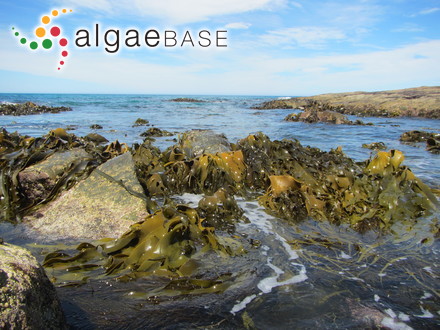Durvillaea amatheiae X.A.Weber, G.J.Edgar, S.C.Banks, J.M.Waters & C.I.Fraser 2017

Current name:
Durvillaea amatheiae X.A.Weber, G.J.Edgar, S.C.Banks, J.M.Waters & C.I.Fraser
Australia - 17 March 2017. X.A.Weber et al
Publication Details
Durvillaea amatheiae X.A.Weber, G.J.Edgar, S.C.Banks, J.M.Waters & C.I.Fraser 2017: 637, fig. 2 b
Published in: Weber, X.A., Edgar, G.J., Banks, S.C., Waters, J.M. & Fraser, C.I. (2017). A morphological and phylogenetic investigation into divergence among sympatric Australian southern bull kelps (Durvillaea potatorum and D. amatheiae sp. nov.). Molecular Phylogenetics and Evolution 107: 630-643, 6 figs.
Type Species
The type species (holotype) of the genus Durvillaea is Durvillaea utilis Bory.
Status of Name
This name is of an entity that is currently accepted taxonomically.
Type Information
Type locality: "Sister’s Bay, southeastern Tasmania, Australia"; (Weber & al. 2017: 639) Holotype: Dr. Christopher Burridge; 08 December 2015; HO; 583407 (Weber & al. 2017: 639) Notes: Isotypesin CANB, BRIS, NSW, MEL, AD and US. Molecular sequences of the holotype deposited with GenBank (28S Genbank: KX446916, COI Genbank: KX548231).
General Environment
This is a marine species.
Description
Large, perennial individual rarely exceeding total lengths of five metres, with thalli generally dark-brown to darktan proximally, becoming lighter distally. Individuals anchored by a thick, crustose non-perforate holdfast, not found to support
burrowing invertebrates. Holdfasts supporting a single flexible cartilaginous terete/subterete stipe to at least 50 cm in length, typically wider in diameter at the bottom than the top. The stipes sometimes consolidated with one, rarely two, other individuals
so that several erect axes cluster together to form a fused holdfast typically less than 10 cm wide. Stipes fan distally through an
apophysis into a laminar blade, with sections 5–30 cm wide and to at least 450 cm long. Blades initially simple, soon bearing up
to forty distichous, laceolate to falcate marginal proliferations (stipitate lateral blades), highly variable in length from 50 mm to lengths exceeding primary blade length. Palmate region infrequently divided into distinct rounded boughs ‘branches’ (sensu
Hay, 1977). Growth diffuse, extension in length concentrated near blade apices, increases in thickness through a meristoderm layer throughout the thallus, with thickest tissue proximal to the palmate region. Blade margins commonly entire, infrequently crenate or serrate. Frequently found with damage as tears and perforations to thallus tissue. Thallus structure solid and non-buoyant; medulla filamentous, of coarse periclinal hyphae, the transition to the anticlinal cortex abrupt, the filaments dichotomously branched, the inner cells linked by short arms connecting through horizontal cross-walls to arms of contiguous cells. Individuals dioecious, female oogonia producing four ova borne on conceptacle walls and male antheridia terminal on simple or branched paraphyses, the ova and antheridia infrequently remaining in conceptacles outside the winter reproductive period.
Similar Species
Durvillaea potatorum
Created: 17 March 2017 by M.D. Guiry.
Last updated: 23 February 2023
Verification of Data
Users are responsible for verifying the accuracy of information before use, as noted on the website Content page.
Linking to this page: https://www.algaebase.org/search/species/detail/?species_id=163426
Citing AlgaeBase
Cite this record as:
M.D. Guiry in Guiry, M.D. & Guiry, G.M. 23 February 2023. AlgaeBase. World-wide electronic publication, National University of Ireland, Galway. https://www.algaebase.org; searched on 16 April 2024















